
Exoplanets

The first planet outside our Solar system to be discovered was 51 Pegasi b. As this artist's depiction shows, it is a gas giant planet orbiting very close to its star.
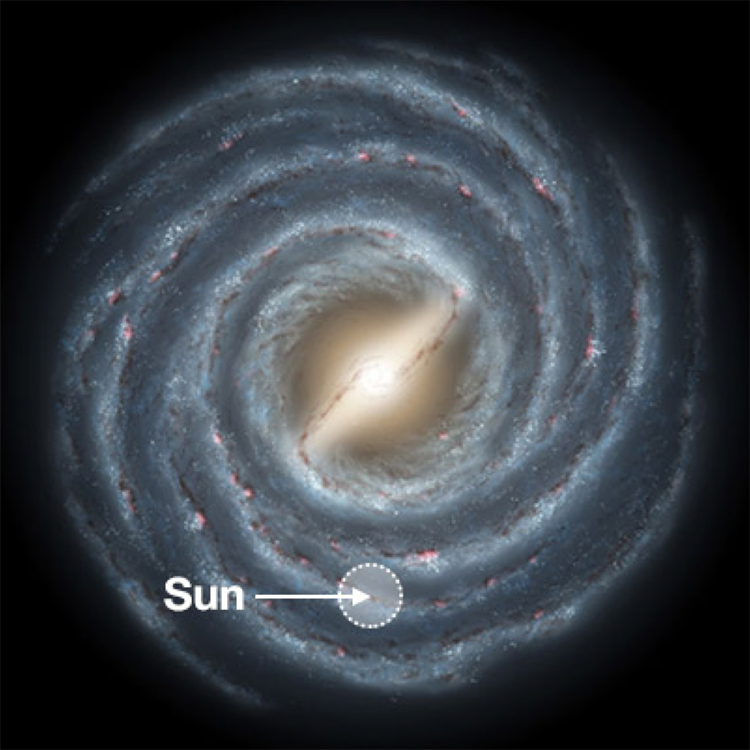
Since 1995, we have found over three thousand confirmed exoplanets, many in multiple planet systems. Our present capability of locating exoplanets is increasing, but still covers a very small volume, compared to the size of our galaxy. This graphic indicates how far away from Earth we are currently able to detect exoplanets.
Exoplanet detection methods
We have five methods for extrasolar planet detection:
(1) variation in radial velocity of the star, detected via the Doppler shift
(2) planet transit: starlight dims as the planet passes in front of the star
(3) direct visual observation
(4) gravitational micro-lensing
(5) astrometry: small movements of the star against background stars
Radial velocity method
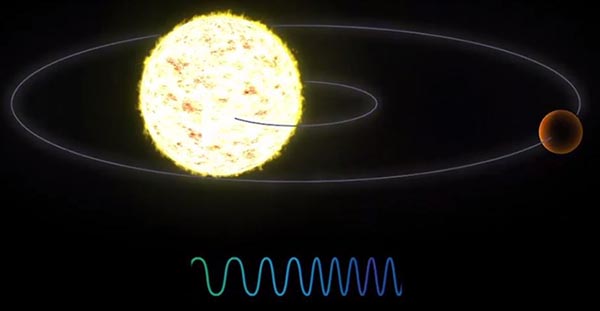
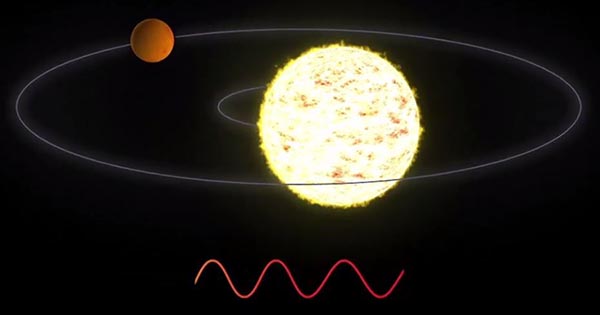
The graphics above, from NASA's Exoplanet Exploration site show how a planet can be detected by measuring the Doppler shift of the starlight. In both images, the star and planet are orbiting in the counterclockwise direction. In the upper image, the planet is moving away from the observer, and the star is moving toward the observer, making the starlight blueshifted. In the lower image, the planet is moving toward the observer, and the star is moving away from the observer, making the starlight redshifted. The Doppler shifting of the starlight allows us to see the star's apparent radial wobble in space, caused by the fact that the star and planet orbit a common center of mass.
This technique works well for large gas giant planets that lie close to low mass stars, since those systems result in the largest motion. It also works best for systems that are viewed edge-on.
Please view this NASA animation to see how the Doppler shifted light relates to the motion of the star in this system. For more information, go to exoplanets.nasa.gov and click on 5 Ways to Find a Planet at the bottom of the page.
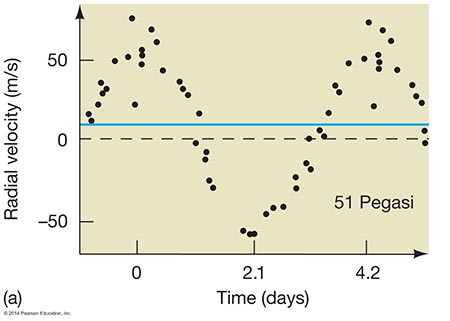

The radial velocity method can be used for multiple-planet systems as well as single-planet systems. The plot on the left shows what the radial velocity shift would look like for a star with a single planet orbiting. The data can be approximated as a simple sine wave. The plot on the left shows a three-planet system. This curve is more complicated than a single-planet system, but can be analyzed to show the addition of three sine waves, one for each planet.
Transit method
When a planet crosses between a star and an observer, it is called a transit. When a planet transits a star, it blocks some of the starlight, so the detected light is dimmer. By measuring how much the light dims, and how long it dims, we can tell the relative size of the planet compared to the star and the orbital period.

The image above depicts the light curves of two transit events. Here the stars are the same size but the planet on the left is larger than the planet on the right. The dip in the light curve on the left is correspondingly deeper than the dip on the right. The times of the transits are about the same.
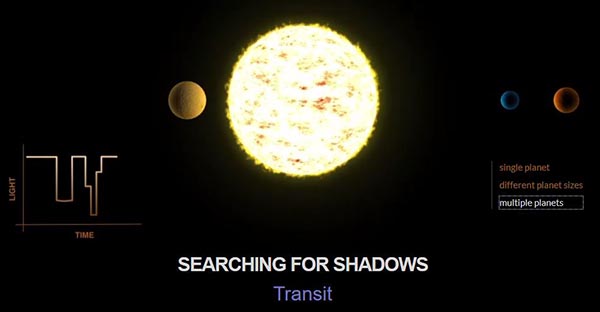
This image shows the light curve for a three-planet system. Here, the larger tan planet passed in front of the star first, making a deep dip in the light curve. The middle-sized red planet then transited the star, and the small blue planet crossed in front of the star while the second planet was still in transit.
Please view this NASA video to see the three-planet transit simulation. The transit method works well for systems that are viewed edge-on and is not suitable for systems that are oriented such that they are seen top-down (from above or below).
Direct visual observation
This method is just what it sounds like, the extrasolar planets are directly seen using a telescope. Planets are very hard to see near a star, because the starlight is so bright that the planet is lost in the glare.
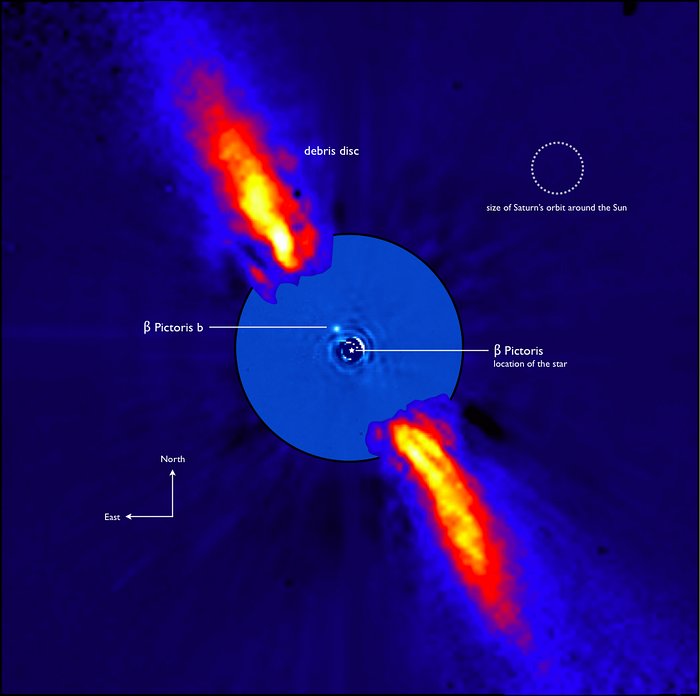
Image Credit: ESO/A.-M. Lagrange et al.
This composite infrared image of a suspected gas giant planet orbiting the young star Beta Pictoris was taken by the European Southern Observatory's Very Large Telescope in the Atacama Desert of northern Chile. The star has been partially masked to reduce glare, to make the planet visible. The planet is about eight times as massive as Jupiter, and lies approximately 8 AU from the star, well inside the dusty disk that is visible in red and yellow.
Gravitational micro-lensing
Gravitational lensing is caused by the warping of space due to a gravitational field. Light takes a curved path in warped space, much like the effect seen when light passes through a lens made of glass. Large, dense astrophysical structures like galaxies and galaxy clusters produce large gravitational lens effects. Smaller bodies like stars and planets produce a much smaller effect, that is much harder to detect.
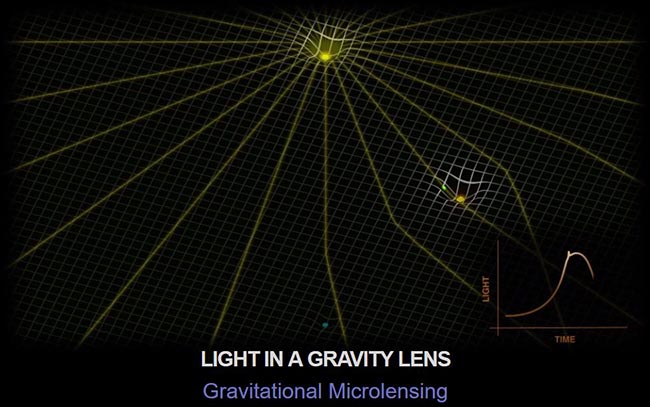
The path taken by the light from a star is curved as it passes through the gravitational field of a planet. This curvature can be seen as a fluctuation in the starlight. Relatively few planets are discovered using this method, since the gravitational lensing effect is small.
Please view this NASA video to see an animation depicting detection of an exoplanet using the gravitational micro-lensing technique.
Astrometry
Astrometry is the detection of time movements of a star, as seen against the background of faraway stars. A star and its planets all orbit a common center of mass. The gravitational tug of the planets causes a star to shift in space. If the shift is great enough to be seen, planets can be indirectly detected.
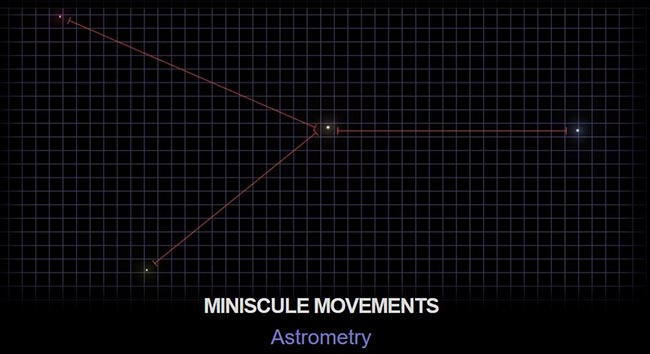
All stars are in motion, but faraway background stars are so distant that their motion cannot be detected. This is much like the effect you see when you ride in a car. Objects by the side of the road appear to move very fast, while objects on the horizon move so slowly that they appear to be sitting still.
By making careful observations using powerful telescopes, the motion of a star in a planetary system can be discerned against faraway background stars.
Please view this NASA video depicting the astrometry method of detecting extrasolar planets.
The premiere discovery of an exoplanet (a planet orbiting a star other than our Sun) by astronomers on Earth happened in 1995.